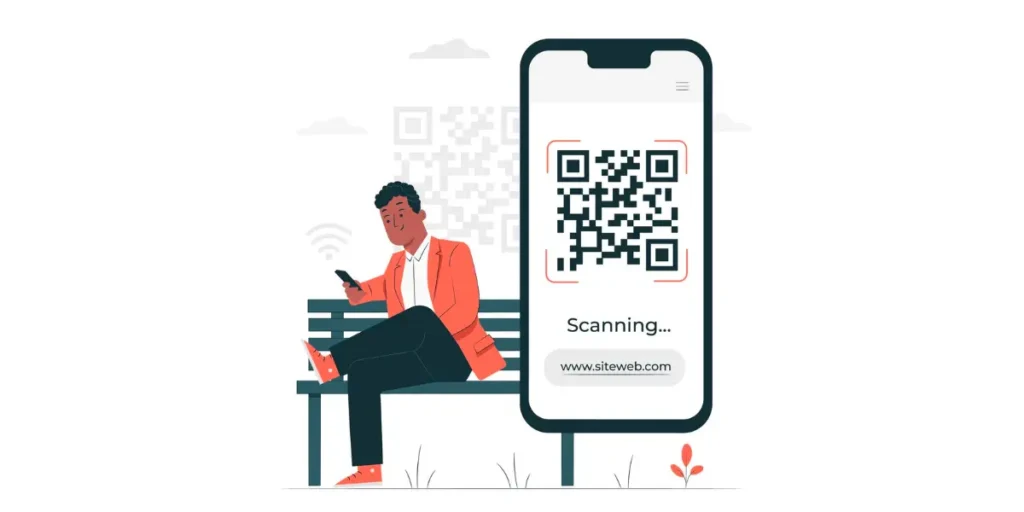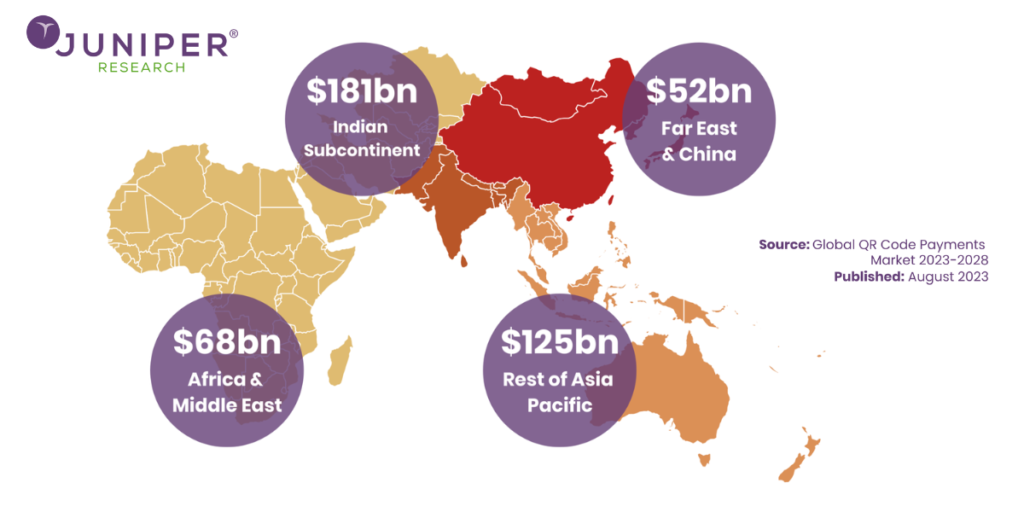QR Code Usage by Country: A Global Overview

QR Codes are everywhere—from restaurants and retail stores to TV ads and commercials.
Their ability to bridge the gap between the physical and digital worlds has made them a favorite among businesses and consumers.
But have you ever wondered how different countries use QR Codes? How does QR Code usage vary across different countries? This article is just about that – QR Code usage by country.
In this article, we will look at the regions where they are an everyday element and discover the parts of the world where they are just gaining momentum.
Let’s begin!
A. What are QR Codes?

Let’s first look at some basics before moving to global use.
So, a QR Code is a two-dimensional barcode that can store all types of information, from basic text, webpage links, or apps to any kind of digital content ever to have existed in the virtual world.
One can scan a QR Code using a smartphone and access the stored content. That’s mostly it. Pretty awesome, right?
Did you know that as of 2023, 44.6% of all internet users around the globe had scanned a QR Code at least once?
Source: Persuasion Nation
QR Codes have grown increasingly popular due to the substantial adoption of smartphones.
Currently, there are 6.84 billion smartphones internationally. It’s anticipated that by 2024, the wide variety of smartphone users might be 7.1 billion.
The pandemic also elevated worldwide QR Code adoption as a contactless solution for sharing menus, bills, and statistics.
While necessity can also have started the primary wave, it is the benefit and versatility that helped maintain their popularity.
B. How QR Codes are used around the world
The use of QR Codes varies extensively throughout different cultures and industries.
Payments: Countries like China and India have heavily adopted QR Code-primarily based cellular payments, making cash almost out of date in positive sectors.
People from every phase of society have started using QR-based payments in their everyday lives.
Marketing and Advertising: QR Codes are broadly used for promotions, coupons, and directing consumers to online content.
Information Sharing: Public locations like museums and traveler attractions have seen the usage of QR Codes to offer additional information or interactive experiences.
Supply Chain Management: QR Codes are vital for tracking merchandise and stock in many nations. Industries in Japan use QR Codes for inventory tracking and management.
C. Regional leaders in QR Code adoption

While QR Codes are used globally, some areas have embraced this generation more enthusiastically than others.
A report by Scanova suggests that international smartphone penetration has skyrocketed from 3.2 billion in 2016 to a soaring 6.8 billion in 2023, which shows an annual increase of 4.2%.
Did you know that as of 2024, the United States is at the leading edge of worldwide QR Code utilization, accounting for 42.2% of worldwide scans from 2022 to 43.9% of 2023.
(Source: The Enterprise World)
Asia: Asia is often considered a pioneer in the adoption of QR Codes. This is not very surprising since QR Codes were invented here.
In 1994, a Japanese corporation called Denso Wave developed QR Codes. However, countries like China and India have heavily integrated QR Codes into their everyday life for payments and information access.
Neighboring Southeast Asian countries provide a very good example of how rapidly QR code technology is spreading.
For instance, Indonesia uses QR codes across many sectors, from retail to government services. QR codes in Thailand are most commonly seen in print marketing. Singapore is using QR codes to advance its status as a smart nation, while in Malaysia, QR codes are experiencing broader adoption among the public. The same goes with the QR Codes in the Philippines, wherein they further help the government by providing better services to the public.
North America: The US and Canada have also seen a significant increase in QR Code usage, particularly in the retail and restaurant sectors. This adoption has gained tremendous traction, especially since the pandemic.
To this effect, even smaller North American countries are adopting QR codes. A good example is QR Code in Mexico, used mainly for making payments and trips in transport.
Also, the Dominican Republic uses QR Codes for travel e-tickets, streamlining customs, immigration, and health declarations into a single digital pass for incoming visitors.
Europe: European countries are gradually catching up, with QR Codes becoming more common in urban areas and among younger demographics.
Although adopting QR Codes is comparatively slower in European countries, recent trends indicate a boom in the coming years.
D. QR Code usage by country

1. QR Codes in China
China leads in the usage of QR Codes; they are an integral part of the country’s day-to-day life.
Payments: China applies them a lot in mobile payments. Applications such as WeChat Pay and Alipay allow users only to scan a QR Code and pay for nearly everything. QR Codes in Hong Kong also contribute significantly to this trend.
By 2022, QR Code transactions in China were worth USD $4 billion dollars. The value was estimated to be more than US$1.6 trillion by 2027, according to a Statista prediction.
Business: QR Codes are used now in restaurants across China, to check the menu and place orders. They’re also being used for payments. Street vendors are also using the same to market their products.
According to The Fintech Times, a report suggested that QR codes are so prevailing in China that around 95% of the population recognizes them.
Health: Monitoring health through QR Codes saw a massive increase during the COVID-19 pandemic. People use QR Codes in public spaces to validate one’s status regarding health.
2. Japan: Where QR Codes were born
QR Codes were invented in Japan. And it is only fitting that even today, they are a part of everyday life here.
An impressive 61% of Japanese consumers have scanned a QR Code at least once in their lifetime.
Travel: QR Codes in Japan are commonly seen on train tickets and boarding passes.
Entertainment: Magazines and products use QR Codes to link to videos or special content. Payment—like in China—gets a foothold in Japan, even if not as wide in scope.
People spent a huge amount of money, almost 15 trillion yen, on paying through QR Codes. This makes QR Code payments even more in vogue than the other ways of payment without cash.
In fact, QR Codes are now the second most used way to pay, surpassing even electronic money.
3. South Korea: Tech-savvy adoption
South Korea is another country where QR Codes have been very popular.
Shopping: QR Codes are used in retail stores in South Korea for payments and discounts. Customers can scan these QRs to get a special offer or to join a loyalty program.
Public Services: QR Codes in Korea are being applied to government services for quick sharing of information.
Entertainment: K-pop Fans scan QR Codes to unlock special content and fan events.
4. India: On the rise

The country with the most extensive use of QR Codes other than China is India, which is a QR Code heaven! It is the second-largest QR Code market globally, with over one million scans in 2022 alone.
That is not very surprising because almost half the population in India uses them. QR Codes in India are mostly website or file-based.
In 2022, India had the second most mobile devices using QR Codes for payments. This accounted for 192.5 million USD.
Banking: Many banks in India have adopted QR Codes for easy fund transfers. Apps like Paytm and Google Pay use them for UPI (Unified Payments Interface) transactions.
By October 2021, Bharat QR Code transactions surged to over 4.5 million in India. Over 9 million merchants in various parts of India now accept QR Code payments.
Retail: QR Codes are increasingly used in shops for payments. You will see them as much at small stalls as inside big stores.
Education: A few educational institutes in India use QR Codes to share study material and student attendance.
Now, QR Codes are used by the University of Delhi on its degree certificates for verification purposes.
Delhi Metro took to QR Codes for a seamless ride. In 2018, the QR Code payment system came to the IGI Metro station.
It was followed by the QR Code-based ticketing facility on the Paytm app in 2023; now, passengers can buy tickets directly from their phones.
Further streamlining things, the Delhi Metro partnered with WhatsApp to offer QR Code tickets in the messaging platform.
That means travelers could have tickets and information available in Hindi and English on all Delhi Metro lines, including the Airport Express and Gurugram Metro.
5. Europe: A mixed picture
The usage of QR Codes across Europe is very patchy.
The United Kingdom: QR Codes in the UK surged in the COVID-19 pandemic. They were used for contact tracing, restaurant menus, and check-ins at places of interest.
As of 2023, the UK was among the top 5 countries that generated the most QR Code creations.
To understand what’s driving this adoption, here’s a closer look at the most popular QR Code generators in the UK and how users are choosing them for business and personal needs.
Germany: In Germany, QR Codes apply to marketing, like on posters or flyers, linking the user to websites. Cash is, however, still preferred over QR-based mobile payments.
According to a Martech Alliance report, 86.66% of UK and European smartphone users said they had scanned a QR Code at least once, while 36.40% scanned at least one QR Code per week.
France: Just like the UK, France has witnessed increased usage of QR Codes since the pandemic, particularly in its hospitality industry.
QR Codes in France have become more common, with 2 out of 3 users surveyed confirming that they have scanned QR Codes at least once in their lifetime.
Switzerland: QR Codes in Switzerland are making waves, especially for e-payments. Since October 1, 2022, companies headquartered in Switzerland have had to use the Swiss QR bill for transactions.
Spain: QR Codes in Spain are witnessing continuous growth, especially in the hospitality and retail sectors. According to statistics, over 70% of restaurants and cafes use QR Codes for digital menus.
This surge is majorly driven by the rise in smartphone usage, making QR Codes a convenient tool for payments and promotions across the country.
Besides this, as a country known for its tourism, QR Codes are also used at monuments to help tourists access information easily.
6. United States: Leader globally
An increasing number of Americans now use QR Codes. According to Statista, almost 90 million American people will use their phones to scan a QR Code this year.
And that number will keep getting bigger: projected to be almost 100 million by 2025.
Marketing: One application that is often used in advertising and marketing campaigns. QR Codes have appeared on outdoor board advertisements, posters, and even TV adverts.
Payments: Though not as pervasive as in China or India, QR Codes in the USA find increasing usage for mobile payments in-store and in restaurants.
Events: QR Codes have been found to be broadly adopted for event tickets and check-ins. The health sector is another area where they are widely used for storing and enrolling patients’ information.
According to another similar report by Statista, around 37% of the respondents were ready to make a payment by scanning a QR Code, especially in a restaurant bar, or event.
7. Brazil: Emerging use
QR Codes in Latin America are becoming increasingly popular, especially in urban areas of Brazil. Rio de Janeiro is bringing history to life with QR Codes!
The city has embedded these codes into its famous mosaic sidewalks to tell stories about Brazil’s past.
You can find one of the first QR Code ever placed on the ground at Arpoador, a rock on Ipanema Beach.
Banking: Apart from tourism, QR Codes are used in banking apps for easy payments and money transfers in Brazil.
The Central Bank of Brazil has launched its standard for QR Codes to universalize cashless payments in the country. The new standard became mandatory in September 2020.
Retail: Some retailers have started using QR Codes for payments and promotions, although this mode of digital transaction is not as common as in other countries.
Health: During the pandemic, QR Codes were used to track and monitor health.
8. Australia: Versatile applications
Australia has seen a versatile use of QR Codes across different sectors.
Check-Ins: QR Codes for contact tracing became widespread in Australia during the pandemic. They are still used in many places for check-ins.
The government of New South Wales, Australia, made it a must for people to check into shops and cafes using QR Codes to aid in contact tracing.
Current reports have revealed that in New South Wales alone, there have been check-ins worth up to over 300 million since when the QR check-in was made mandatory in November 2020.
Marketing: Companies in Australia use QR Codes in marketing to direct clients to websites, promotions, or simply apps.
Education: Multiple schools and colleges deploy the use of QR Codes to either avail of a resource or mark attendance.
By 2024, the transaction value of Mobile POS Payments may reach nearly $54.36 bn.
In nearby New Zealand, QR Code usage also surged, especially during the pandemic for contact tracing, business operations, and event management.
9. Africa: The upcoming frontier
QR Code use in many African nations is at an early stage but is increasing.
Mobile Payments: QR Codes in Africa are now being experimented with in different countries such as Kenya and Nigeria, for making mobile payments. For example, there are apps like M-Pesa in Kenya that are at the forefront.
In the same period of 2024 to 2028, the African market for mobile POS is expected to reach a CAGR of 16.55% to touch $179.30 billion.
Healthcare – Some areas are slowly adopting QR Codes in their tracking and health services.
Retail: Although it is still not very widely used, some stores have started to adopt QR Codes for payments and promotions.
This is mainly done for promotional purposes in tourism and to decrease the risks involved in carrying money in note form.
10. Canada
With gradual penetration into Canada, QR Codes are finding steady adoption. Just a couple of years ago, it was a relatively new thing, but now they are all over the place.
Only approximately 5,500 were in operation in 2021. Fast forward to mid-year 2023, and the number has gone up to a whopping 20,000! That is a 4x increase in the number of QR Code creations. It is, therefore, clear that Canadians have really embraced this technology.
Across restaurants, QR Codes are used on menus and even to make payments. Like in other countries, during the pandemic, QR Codes were used for health monitoring purposes and check-ins.
These days, many stores across Canada leverage QR Codes to contest promotions and customer engagement programs.
Canada ranks 10th in the top 10 countries on QR Code generation. What’s more, in the year 2022, Canada registered a whopping 1.7 million QR Code scans across the nation.
11. Russia: Gradual implementation
QR Code usage is generally growing in Russia. In some Russian cities, QR Codes are used for payments for public transport and at retail stores.
In 2017, the use of QR Codes on 200 and 2,000 Ruble notes was introduced by the Central Bank of Russia and the National Mint Goznak.
QR Codes in Russia are common in event tickets, and to check into venues nationwide. Its use also skyrocketed during the pandemic in health tracking and contact tracing.
As of March 2024, a foreigner who was vaccinated with Sputnik V in Russia had to have an SNILS number—the Russian equivalent of the Social Security number—to be issued a QR Code.
12. Middle East: Increasing inquiries
In Middle Eastern countries like the UAE and Saudi Arabia, QR Codes are seeing growing interest. They are increasingly put to use in shopping malls for promotions and payments.
Banks incorporate this technology into their mobile banking services. Indeed, digital payments using QR Codes in the United Arab Emirates (UAE) expanded by more than 9% annually between 2014 and 2019. This was swifter than the average annual expansion of 4% to 5% which was seen in Europe.
QR Codes in the Middle East are used in tourism to gain access to information regarding historical sites and points of interest.


E. Challenges and opportunities
Despite widespread adoption, some challenges still persist, mainly relating to low smartphone penetration, digital illiteracy in many regions, and data privacy concerns, all of which might restrain its growth.
On the other hand, new technologies such as AR or QR Code-based loyalty programs present a whole new promising field of innovations.
Conclusion
The future for QR Codes is huge. The more innovative countries and industries find ways of putting them into action, the greater their use will be in our lives within this ever-advancing digital world.
The speed at which this technology is adopted will differ from country to country, but the overall direction is clear: QR Codes are there to stay.

